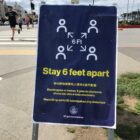This article is adapted from an episode of our podcast “Civic.” It is the second in a two-part series examining factors contributing to the country’s extreme wealth inequality and how it impacts Bay Area residents. Click the audio player below to hear the full story. Read and listen to Part I here.
When we examine the massive wealth gap between the rich and poor in this country, what stands out most is how differently it affects the country’s white and Black populations. According to data from the Federal Reserve Board’s Survey of Consumer Finances, the typical Black family has $24,000 in wealth. That is less than 13% of the $190,000 in wealth held by the typical white family.
This racial wealth gap is rooted in a long history of racist policies, including the progressive programs meant to mitigate inequality during the Great Depression. New Deal programs like the GI Bill helped millions of World War II veterans secure housing by promoting homeownership through federally backed loans and guaranteed mortgages. But it was real estate moguls who laid the groundwork for the subsequent National Housing Act of 1934.
From this act, a new federal agency was formed called the Homeowners Loan Corporation. The corporation decided who qualified for a loan with residential security maps that became the standard to determine the best places for housing investments. Black communities, regardless of their economic status, were given a grade D rating and branded as hazardous and high risk — no federally backed loans would be made there. And so, the vast majority of Black Americans did not qualify, according to Venise Wagner, a journalism professor at San Francisco State University who wrote the award-winning article, “Living Red: Black Steel Workers and The Wealth Gap.”
“They created maps,” Wagner said, describing the Homeowners Loan Corporation’s practices. “And then these maps, they designate the homes that would be viable for this mortgage program. And if the area was Black, then it was considered blighted.”
Racist covenants on residential properties barred people of color from renting or owning a home in certain neighborhoods.
“If a white person dared rent to a Black person, or if a white person dared to sell a home — then they basically were subject to a white mob violence,” Wagner said. “People would be so upset they would literally throw firebombs into the home. To scare them, they would write threatening notes saying, ‘You better get out of here, or we’re going to kill you.’”
These covenants were codified into law in a practice that’s now referred to as redlining. Redlining locked out millions of Black families from accessing mortgages and opportunities to build wealth to pass down to future generations. Although the practice was outlawed with the signing of the 1968 Fair Housing Act, much damage was already done.
“There are areas here in the Bay Area, if you look at the old redlining maps, you can juxtapose them and see the areas of distress that remain today,” Wagner said.
Living in segregated communities has modern day consequences, including sharp disparities and family wealth, education and life expectancy. These maps were made more than 80 years ago, and yet they still impact families today, including Wagner’s family.
“I’m probably the only person who owns a condo in my family — who has a mortgage,” Wagner said. “My mother and father don’t. My brother doesn’t. My other brother doesn’t. My sister doesn’t. My grandfather’s other daughter, she had a mortgage for a short while with the help of her brother. That ended up in smoke. But through predatory lending.”
That predatory lending — in which people were approved for mortgages that by traditional lending standards would be considered large relative to their monthly incomes — led up to the subprime mortgage crisis of 2007 to 2009. That’s when the bottom 90% of Americans saw one-third of their wealth wiped out. And there’s a direct correlation between the people who were targeted with predatory lending schemes and redlining practices.
“If you were to look at the redlining maps and look at the area where subprime loans were primarily targeted, you would see they were targeted at formerly redlined communities,” Wagner said. “So, all I can say is that history keeps repeating itself.”
Derrick Soo is among the vast number of Americans wiped out by the subprime mortgage crisis. He lives in a city-sanctioned homeless encampment in Oakland. His family also suffered from racist covenants that excluded nonwhites from certain neighborhoods. He vividly remembers what happened to his family in 1964 when his mother’s boss invited them to a Christmas party. He was just four years old.
“That was an area that was still off limits to Chinese people, or people of color. It was a white only city,” Soo said. “Within four blocks, a Piedmont police officer had his lights on us and pulling us over. The officer was very rude, making a lot of racial comments about our race not being allowed in that city. And were we too stupid or didn’t read and understand English.
“I was terrified. I’m scared because you have a Caucasian cop with a gun, a badge, and the authority to do whatever he wanted, pretty much, and say we were trespassing in an all-white city.”
Today wealth inequality is most acute among people of color. Since 2005, African Americans and Latinos have made up about 60% of the lowest income families in each state, but they make up just 40% of the total population.
Research by New York University sociology professor Patrick Sharkey, who studies multigenerational disadvantage, shows that about half of African American families have lived in the poorest quarter of neighborhoods not just in a single generation, but over consecutive generations. Only about 7% of white families live in poor neighborhoods over multiple generations.
“Once we begin to think about inequality over generations, as opposed to snapshots of an individual’s life, we start to get a very different picture about the consequences of living in a poor neighborhood where we go to school, the quality of the air we breathe, the social networks that we form, types of economic opportunities available to us,” Sharkey said in an online lecture for the Stanford Center on Poverty and Inequality. “All of these things come bundled in space and affect the life chances of everyone that lives within a particular neighborhood.”
Income gains were widely shared for about a quarter-century after World War II, thanks in large part to income taxes. By 1944, the top marginal tax rate was 94% on all income over $200,000 — $3.2 million today. Diane Frey, a labor studies professor at San Francisco State University and co-editor of the textbook “Human Rights and Economic Inequalities,” said it was during that time that the labor class rose up.
“People had sacrificed for so long during the war, people hadn’t been able to buy things,” she said. “There was a lot of pent-up demand of people coming back and saying, ‘okay, we’ve worked this hard, we want a piece of the American dream, we want to have a nice house, we want to be able to buy a car.’ And so, there was kind of enhanced labor militancy following World War II. And part of that was massive strikes.”
From 1945 to 1946, the country experienced a series of massive strikes spanning numerous industries and public utilities. In the year after Japan surrendered on Aug. 15, 1945, more than five million workers were involved in labor actions. They were the largest strikes in American labor history. Then came the backlash.
“It became, began to be perceived, particularly by the right wing, all labor unions have too much power, we need to kind of clip their wings. They’re holding us hostage,” Frey said.
“We need to try to really carve take back some of the rights that were given in the original National Labor Relations Act. And that was the whole battle over Taft-Hartley, which basically kind of rolls back protections in the original National Labor Relations Act.”
The Taft-Hartley Act of 1947 prohibited all kinds of strike actions, as well as secondary boycotts, closed shops and monetary donations by unions to federal political campaigns. President Harry Truman called the bill “a shocking piece of legislation” that undermined democracy.
“Unions exist so that laboring men can bargain with their employers on the basis of equality. Because of unions, our living standards of our working people have increased steadily, until they are today the highest in the world. A bill which would weaken unions would undermine our national policy of collective bargaining. A Taft-Hartley bill would do just that. It would take us back in the direction of the old evils of individual bargaining.”
Truman vetoed the bill, but was overridden.
“And so, we see the whole rise of union busting law firms and social psychology of union busting,” Frey said.
Sponsors of the bill claimed that by weakening unions, they were giving rights back to individual working men. That ideology took hold in the 1970s during rampant inflation and an oil shock, Frey said. It continued into the 1980s, when President Ronald Reagan gave numerous speeches extolling the “faith in the individual.” He also likened individual freedoms to a free market.
“We protect the freedom of expression of the author as we should,” he said. “But what about the freedom of expression of the entrepreneur whose pen and paper are capital and profits? Whose book may be a new invention or small business?”
This was from a 1984 speech that he gave before signing into law a bill that would give wealthy Americans the lowest tax rate in the industrialized world.
Reagan cut income tax for millionaires and multimillionaires from 74% to 25%. There were no billionaires in America then, in large part because of previous tax policies. But after Reagan’s massive tax cuts, followed later by cuts by then-presidents George W. Bush and Donald Trump, the country began seeing an explosion of billionaires. Meanwhile, median and minimum wages plunged faster than they had since the Great Depression.
Reagan also took further measures to weaken labor unions. He started by famously firing 11,000 striking air traffic controllers in 1981, crushing that union in less than two weeks. Over the next decade, union membership went from about one-third of the American workforce to around 10% at the end of the Reagan and George H. W. Bush presidencies.
Disempowering unions had a huge impact on widening the wealth gap.
“We found that de-unionization explains about a third of the growth in inequality for men and about a fifth of the growth in inequality for women,” said Bruce Western, professor of sociology and social justice at Columbia University, during an online lecture for the Stanford Center on Poverty and Inequality.
That’s because nonunion employers often looked to unionized firms to determine competitive wages. This also exerted influence in politics, keeping alive the conversation about equity among workers.
“So, there were norms in the labor market, in which people had beliefs about what a fair level of wages should be, and what a fair distribution of wages should look like,” Western said.
Reagan was so successful in shaping the narrative that we still use similar language today. Blaming poverty on the poor and claiming government was the problem, not the solution, became such a popular talking point by the 1990s that even Democrat Bill Clinton used similar words to overhaul the country’s welfare system.
“For so long, government has failed us, and one of its worst failures has been welfare,” Clinton said in a 1992 ad. “I have a plan to end welfare as we know it to break the cycle of welfare dependency. We’ll provide education, job training and childcare. But then those who are able must go to work, either in the private sector or in public service. It’s time to make welfare what it should be: a second chance, not a way of life.”
Opponents argued that punitive and unnecessary rules blocked beneficiaries from improving their circumstances. For example, adults without a high school diploma couldn’t get an advanced education because they had to spend much time working or volunteering to continue receiving benefits.
Top Democratic Party leaders continued to promote the notion of limited government for the next two decades. President Barack Obama evoked similar themes during his 2012 State of the Union Address.
“I’m a Democrat, but I believe what Republican Abraham Lincoln believes — that government should do for people only what they cannot do better by themselves and no more,” he said to thunderous applause.
This was an era when the pro-free-market drumbeat caught hold, thanks to right wing radio hosts. As Politico reported in 2014, conservatives backing the Tea Party spent nearly $22 million between 2008 and 2012 on influential talkers like Glenn Beck, Sean Hannity, Laura Ingraham and Rush Limbaugh. By 2016, Trump was emboldened to take on the labor unions. He marked Labor Day that year by attacking the head of America’s biggest labor union.
Policies have shifted with the election of President Joe Biden. He has endorsed a major tax increase on accumulated wealth that would target the top .01% of households. In March, he proposed a “Billionaire Minimum Income Tax” — a 20% minimum tax on households worth more than $100 million.
“When people see that we can’t really grow our way out of this,” Frey said, “the only thing that’s left is redistribution. That is the only solution that we can’t have everybody having nothing and a few folks having everything.”
But the ultra-wealthy always have a way to pass immense fortunes to their heirs without paying any estate tax. Currently, some are exploiting a loophole that lets them quickly churn assets in and out of trusts to make inheritances look smaller than they really are. As ProPublica revealed, the grantor retained annuity trust is estimated to have cost the U.S. Treasury about $100 billion over the prior 13 years.
This also serves to fuel inequality.
“It goes back to power,” Frey said. “Because if you have all the wealth, you don’t want to give it up. And so, you’re going to use all of your resources. And if you’re Jeff Bezos, you have more resources than anybody, and your chances of winning are pretty good. So, I think that it’s really a battle.”
CORRECTION 5/12/22: The text in the section about strikes was modified to consolidate descriptions of events that were previously mentioned out of chronological order, to clarify their relation to each other.










